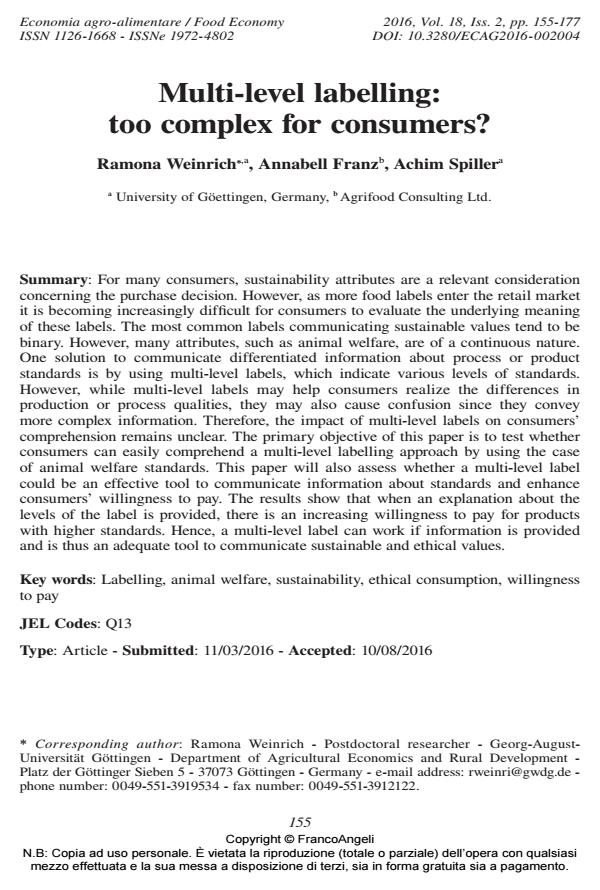Multi-level labelling: too complex for consumers?
Titolo Rivista ECONOMIA AGRO-ALIMENTARE
Autori/Curatori Ramona Weinrich, Annabell Franz, Achim Spiller
Anno di pubblicazione 2016 Fascicolo 2016/2
Lingua Inglese Numero pagine 18 P. 155-172 Dimensione file 161 KB
DOI 10.3280/ECAG2016-002004
Il DOI è il codice a barre della proprietà intellettuale: per saperne di più
clicca qui
Qui sotto puoi vedere in anteprima la prima pagina di questo articolo.
Se questo articolo ti interessa, lo puoi acquistare (e scaricare in formato pdf) seguendo le facili indicazioni per acquistare il download credit. Acquista Download Credits per scaricare questo Articolo in formato PDF

FrancoAngeli è membro della Publishers International Linking Association, Inc (PILA)associazione indipendente e non profit per facilitare (attraverso i servizi tecnologici implementati da CrossRef.org) l’accesso degli studiosi ai contenuti digitali nelle pubblicazioni professionali e scientifiche
For many consumers, sustainability attributes are a relevant consideration concerning the purchase decision. However, as more food labels enter the retail market it is becoming increasingly difficult for consumers to evaluate the underlying meaning of these labels. The most common labels communicating sustainable values tend to be binary. However, many attributes, such as animal welfare, are of a continuous nature. One solution to communicate differentiated information about process or product standards is by using multi-level labels, which indicate various levels of standards. However, while multi-level labels may help consumers realize the differences in production or process qualities, they may also cause confusion since they convey more complex information. Therefore, the impact of multi-level labels on consumers’ comprehension remains unclear. The primary objective of this paper is to test whether consumers can easily comprehend a multi-level labelling approach by using the case of animal welfare standards. This paper will also assess whether a multi-level label could be an effective tool to communicate information about standards and enhance consumers’ willingness to pay. The results show that when an explanation about the levels of the label is provided, there is an increasing willingness to pay for products with higher standards. Hence, a multi-level label can work if information is provided and is thus an adequate tool to communicate sustainable and ethical values.
Parole chiave:Labelling, animal welfare, sustainability, ethical consumption, willingness to pay
Jel codes:Q13
- The Hierarchical Utility of Credence Attributes of Orange Marmalade: What do Consumers Look for in a Multi-Claim Food Product? Giuseppe Di Vita, Raffaele Zanchini, Daniela Spina, Gioacchino Pappalardo, Emanuele Schimmenti, Mario D’Amico, in Journal of Marketing Communications /2025 pp.679
DOI: 10.1080/13527266.2023.2273539 - How green is your packaging—A comparative international study of cues consumers use to recognize environmentally friendly packaging Carsten Herbes, Christoph Beuthner, Iris Ramme, in International Journal of Consumer Studies /2020 pp.258
DOI: 10.1111/ijcs.12560
Ramona Weinrich, Annabell Franz, Achim Spiller, Multi-level labelling: too complex for consumers? in "ECONOMIA AGRO-ALIMENTARE" 2/2016, pp 155-172, DOI: 10.3280/ECAG2016-002004